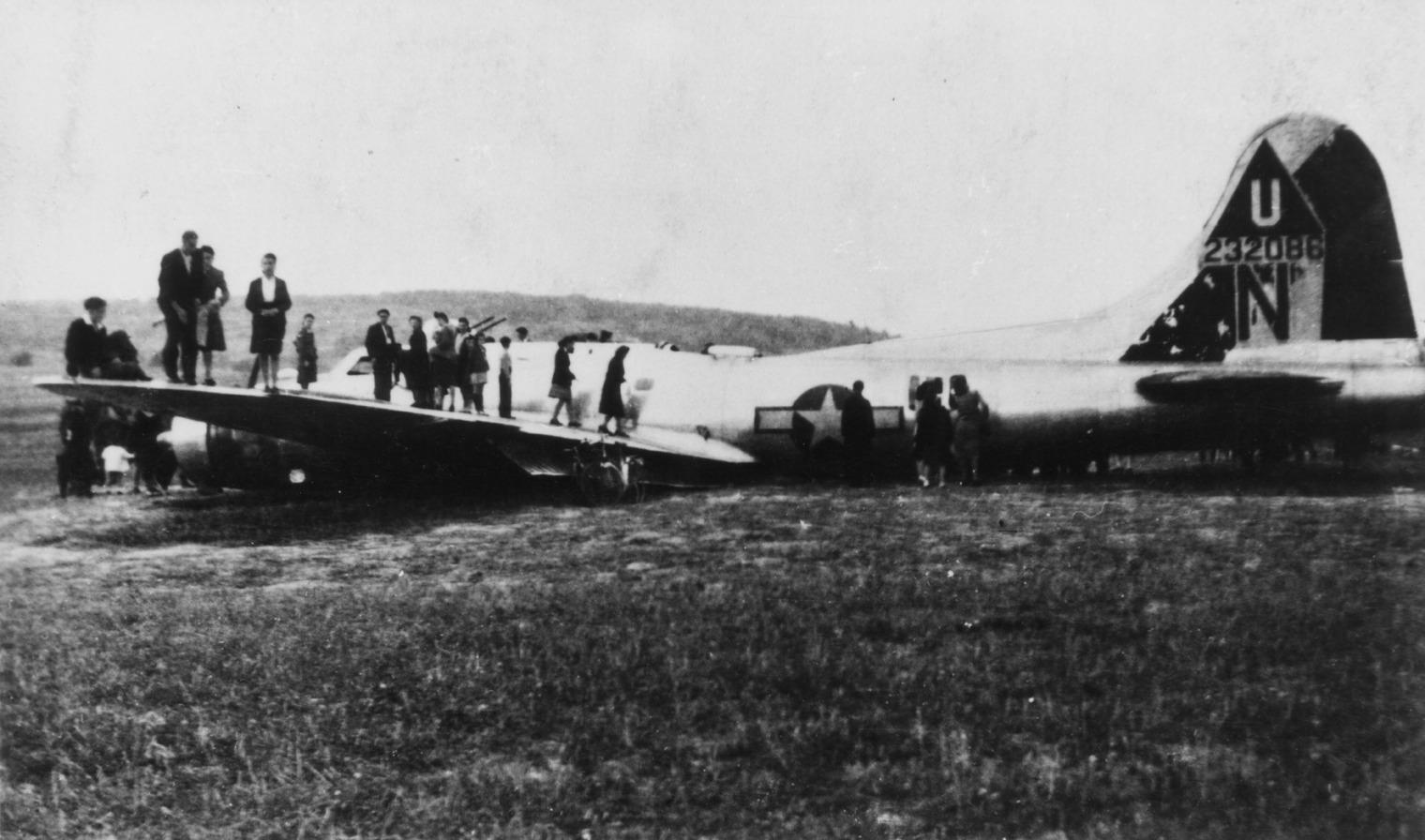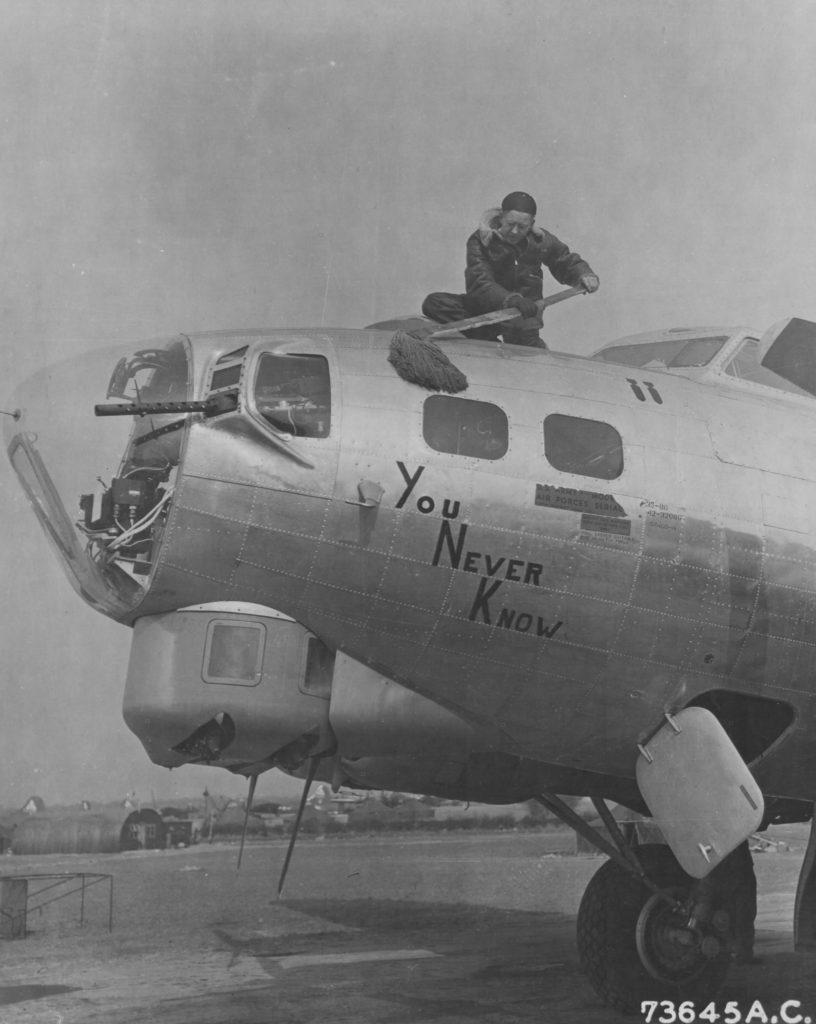 zoom_in
zoom_in
Source:
www.americanairmuseum.com
Production-block:
B-17G-35-BO: 42-31932 to 42-32116
Manufacturer:
Boeing
- Bomb Group:
- 401st Bomb Group
- 457th Bomb Group
- Bomb Squadron:
- 749th Bomb Squadron
- RCL: N
Project-Number:
92469-R
MACR: 8904
History of
B-17 42-32086 / You Never Know
Delivered Cheyenne 22/1/44; Kearney 7/2/44; Presque Is 18/2/44; Assigned 401BG Deenethorpe 3/3/44; transferred 749BS/457BG [N] Glatton 5/3/44; battle damaged Mannheim 9/9/44 with Loren Hampton, Co-pilot: Earl Johnson, Navigator: Bob Mattox, Bombardier: Andy Friesen, Flight engineer/top turret gunner: Maurice Diehl, Radio Operator: Russ Karl, Ball turret gunner: Cliff Digre, Waist gunner: John Brown, Waist gunner: Alex McDermott,Tail gunner: Glen Seeber (8 Returned to Duty); Flight engineer/top turret gunner: Earl Rinehart (Killed in Action); wg-Mike Pipcock (POW, Murdered on 24/25 November 1944) ,Tail gunner: Glen Seeber (KIA); but bailed out before ship force landed friendly territory at Joigny, France; ret 11/9/44; according to one source, probably sustaining battle damage and mixed up with operation to Gaggenau the following day.); crash landed between Senan, Neuilly and Champlay, France. Salvaged 15/2/45. YOU NEVER KNOW.
Last updated: 11. July 2021
B-17 42-32086 / You Never Know Details

Description of extent of damage to missing aircraft
Elevator trim tabs out, interphone out. Number 4 engine hit; could not be feathered; was windmilling. Number 2 engine on fire. Many flak holes in A/C.
Statements to the incident
Glen Seeber and Mike Pipock jumped out south of Nancy, France. We were flying over a mountainous area between 4,000 and 6,000 feet. Civilians on one of the slopes were shooting 20 mm. and .50 cal. at the plane. A 20 mm. hit the ship just to the right and even with the sill of the door. It exploded wnen it hit the ship. Seeber was hit in the leg by some of the pieces. As soon as Seeber was hit, Pipock, who was standing by the door on the tail wheel side, balled out and Seeber, who was sitting by the door, threw himself out the door.
Sgt. Thomas V. Farrell
Ball Turret Gunner
Werbung/Advertisement
We were first hit by flak about 1 minutes before “bombs avay” but were able to stay in formation long enough to drop our bombs with the rest of the ships. Before “bombs away” we were hit by three bursts of flak. Just after “bombs away”, #4 went out. The Co-Pilot hit the feathering switch, but the prop didn’t feather. Also the elevator trim tabs were shot out. We lost the formation. The interphone was shot out, and not being able to hear the Navigator, I took up a 270° heading, knowing that we were nearly due east of Paris and friendly territory. After things got a little settled and we were out of the flak, I switched to Command and followed the Navigator. The ship was on Auto-Pilot, but due to the windmilling prop, we were losing altitude fast, even with full 2500 R.P.M. and 45″ on the good engines. Over Strasbourg, we hit flak at about 21,000 feet. We took evasive action, and by the time we got out of it, we were down to about 17,000 feet.
We must have been hit about five or six times. That was when the Navigator got his wound. Shortly after that, I had him go back in the radio room in case we should make a landing. Since he thought his leg was broken, I thought it would be better for him if we crash-landed. The Bombardier took over the navigating. Near Nancy, we were shot at again and the tail gunner was hit. He and the Waist Gunner bailed out. At that time we must have been at about 4, 000-6,000 feet. It was then that I made up my mind about what we would do. We began looking for a town which we were sure was in free land. At about 3,000 feet, I levelled out and flew at a speed of about 110-115 m.p.h., still with full boost. We saw a small town in some hills, with a level field near it. It seemed a fair place for a landing, so I started to circle. Just as I started a left turn, they began shooting at us again. The hills ahead of us seemed higher and somehow we managed to climb enough to get over them.
Sometimes the air speed dropped to 105 m.p.h. Over those hills, civilians shot at us with small stuff. We were so low that the boys could see how they were dressed. During this time, they were throwing out some of the ammunition, etc. The Bombardier was unable to pick up a definite pin-point, so we kept flying, determined not to land in enemy hands and to make Paris, if possible. We had the gas out of #4 tank and our gas was running low. At Joigny, France, the Bombardier located himself definitely and at the same time #2 engine caught fire. We had only 150 gals. gas left for three engines anyway. Well, there was only one thing to do. We landed wheels up about 4 miles south of Joigny, which is about 100 miles southeast of Paris. In about 45 minutes, the Navigator was in the French hospital and his leg was care of. The rest of us wer uninjured and were drinking swell French wines and eating German canned rations which the F.F.I. had captured. That evening they took me to an American unit, a small Q. M. outfit, where I reported that accident. The next morning, they took us back to Paris, where we got a plane and came home.
1Lt. Loren G. Hampton
Pilot
Source: MACR 8904
B-17 42-32086 / You Never Know Crew
| Position | Rank | Name | Status | Note |
|---|---|---|---|---|
| P | 1LT | Loren G. Hampton | RTD | - |
| CP | 2LT | Orville K. Hocker | RTD | - |
| NAV | 2LT | Robert E. Mattox | RTD | - |
| BOMB | 2LT | Andrew R. Friesen | RTD | - |
| ENG/TT | S/SGT | Maurice A. Diehl | RTD | - |
| RO | S/SGT | Russel G. Karl | RTD | - |
| BT | SGT | Thomas V. Farrell | RTD | - |
| WG | SGT | Michael Pipock | POW | Murdered on 24/25 November 1944 |
| TG | SGT | Glen E. Seeber | KIA | - |






Write comment